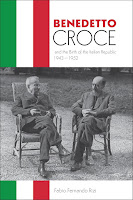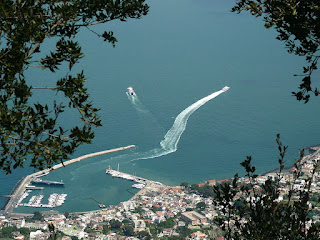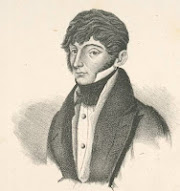NEW - Ischia earthquake
The day calamity and chaos came to Casamicciola
Around 3,000 people are thought to have been killed and many more injured on this day in 1883 after a devastating earthquake shook the island of Ischia in the Gulf of Naples. Although the earthquake was officially classified as moderate, it caused extreme ground shaking, which led to the collapse of about 80 per cent of the buildings in the comune of Casamicciola Terme, a resort on the northern side of the island. Most of the houses, hotels, and churches in the town collapsed. There were more than 1,700 fatalities in Casamicciola alone. The philosopher Benedetto Croce was on holiday on the island at the time and both his parents and his only sister were killed in the earthquake. He was trapped under the rubble for two nights until he was able to be rescued, and it was discovered that he had a broken leg and arm. Read more…
_______________________________________
Luigi Musso - racing driver
Wealthy Roman who found expectations hard to bear
Luigi Musso, who for a period of his life was Italy’s top racing driver, was born on this day in 1924 in Rome. Musso competed six times for the world drivers’ championship, three times for Maserati and three times for Ferrari. He finished third in the 1957 season, driving for Ferrari. His solitary Formula One Grand Prix victory came in 1956 in Argentina, although he had to content himself with a half-share of the points after being forced to hand over his car to Juan Fangio, the Ferrari team leader, after 29 of the 98 laps, when Fangio’s car failed. Sadly, two years later he was killed in an accident at the French Grand Prix in Reims, which his girlfriend, Fiamma Breschi, blamed on the ferocity of his rivalry with his fellow Ferrari drivers Mike Hawthorn and Peter Collins. Born into a wealthy Roman family – his father was a diplomat – Musso grew up in a luxurious palazzo off the Via Veneto. Read more…
_______________________________________
Riccardo Muti - conductor
Celebrated maestro of the baton
The brilliant conductor and musical director Riccardo Muti was born on this day in 1941 in Naples. Until 2023, Muti was conductor of the Chicago Symphony Orchestra and is still the director of the Luigi Cherubini Youth Orchestra, a training ensemble for talent from Italian and other European music schools, based in Ravenna and Piacenza, which he founded in 2005. Previously, Muti held posts at the Maggio Musicale in Florence, the Philharmonia Orchestra in London, the Philadelphia Orchestra, the Teatro alla Scala in Milan and the Salzburg Whitsun Festival. He was named principal conductor and music director for the Maggio Musicale when he was only 28 and stayed there 12 years. He was at La Scala for 19 years from 1986 to 2005, his tenure ending amid rancour following a conflict with the theatre's general manager, Carlo Fontana. Read more…
Vittorio Valletta - industrialist
Agnelli lieutenant who turned Fiat into an auto giant
The industrialist Vittorio Valletta, whose diplomatic and deal-making skills helped him turn Fiat into the beacon of Italy’s postwar recovery, was born on this day in 1883 in Sampierdarena, a port suburb of Genoa famous for shipbuilding. He joined Fiat in 1921, quickly rising to the top and became effectively the right-hand man to founder and president Giovanni Agnelli, as CEO practically steering the company single-handed through the turmoil of the Second World War. After Agnelli’s death in 1945 he became president and remained in control of the company until 1966, when he finally handed over to Gianni Agnelli, the founder’s grandson, at the age of 83. Under his leadership, Fiat grew to such a position of dominance in postwar Italy that at one stage 80 per cent of cars bought in Italy were made by Fiat. The company’s factories employed almost 100,000 people, fulfilling Giovanni’s ambition. Read more…
______________________________________
San Marino’s liberation from Fascism
The day the people demonstrated against their government
San Marino residents celebrate the anniversary of their liberation from Fascism on this day every year. The Sammarinese Fascist Party had been founded in 1922 by Giuliano Gozi, a veteran of the First World War who came from a rich and powerful family. The party was modelled on the Fascist party of Italy and used violence and intimidation against its opponents. Gozi took the roles of both foreign minister and interior minister, which gave him control over the military and the police. He continued to serve as foreign minister, leading the cabinet, until 1943. In 1923 Gozi was elected as San Marino’s Captain Regent. The Fascists retained this post for 20 years as they banned all other political parties, although some independent politicians continued to serve in the Grand and General Council of the Republic. Read more…
______________________________________
Book of the Day: Benedetto Croce and the Birth of the Italian Republic, 1943-1952, by Fabio Fernando Rizi
As president of the Italian Liberal Party, Benedetto Croce was one of the most influential intellectuals involved in Italian public affairs after the fall of Mussolini. Placing Croce at the centre of historical events between 1943 and 1952, Benedetto Croce and the Birth of the Italian Republic details his participation in Italy’s political life, and his major contributions to the rebirth of Italian democracy. Drawing on a great amount of primary material, including Croce’s political speeches, correspondences, diaries, and official documents from post-war Italy, this book illuminates the dynamic and progressive nature of Croce’s liberalism and the shortcomings of the old Liberal leaders. Providing a year-by-year account of Croce’s initiatives, author Fabio Fernando Rizi fills the gap in Croce’s biography, covering aspects of his public life often neglected, misinterpreted, or altogether ignored, and restores his standing among the founding fathers of modern Italy.Fabio Fernando Rizi was born in Italy and received his PhD from York University. He was President of the Dante Society of Toronto for several years, and worked for the Toronto Public Library until his retirement. His first book, Benedetto Croce and Italian Fascism, is also published by University of Toronto Press.
.jpg)
.jpg)
.jpg)




_-_n._8180_-_Casamicciola_-_Piccola_Sentinella.png)






.jpg)
.jpg)

.jpg)


